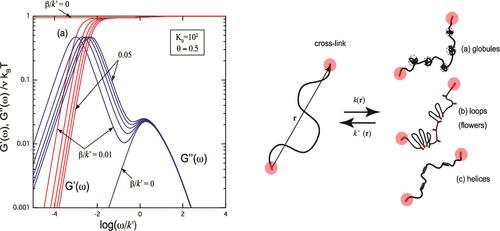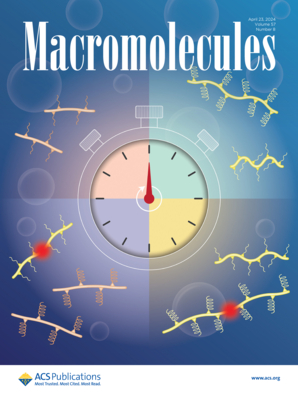刺激响应型瞬态聚合物网络的粘弹性能
IF 5.1
1区 化学
Q1 POLYMER SCIENCE
引用次数: 0
摘要
长期以来,交联聚合物网络中的化学反应一直是聚合物科学的研究重点,因为这些反应与网络流变学密切相关。特别是,在各种刺激(如热、pH 值、光、盐和机械触发)下发生的可逆反应有望广泛应用于新概念和材料功能的开发。本文以瞬态网络模型的理论框架为基础,研究了由聚合物链组成的交联聚合物网络的流变特性。我们发现,一般来说有两个基本的弛豫时间:一个是反应速率(化学弛豫时间),另一个是交联的寿命(流变弛豫时间)。为了具体了解它们之间的相互作用,我们将重点放在球状物、花胶束、环状物、螺旋状物等的形成上,将其视为一阶化学反应,并计算作为反应速率常数和交联解离速率函数的动态机械模量。在永久性交联(反应性橡胶)的极限中,我们发现了一个有限的损耗模量,在与化学弛豫时间相对应的频率上显示出一个峰值。存储模量有所降低,但在低于该峰值的角频率范围内仍保持有限。ω=0极限下的平衡存储模量是反应速率常数的函数。对于具有有限寿命的可逆交联的瞬态聚合物网络,会出现两种独立模式的竞争:慢速模式(流变模式)和快速模式(化学模式),与速率方程的两个特征值相对应。因此,我们可以看到复模量采用了现象学布尔格斯模型的形式。它们的弛豫时间和高原模量是根据分子参数求得的。对这种反应性布尔格斯流体的粘弹特性进行了详细研究。本文章由计算机程序翻译,如有差异,请以英文原文为准。

Viscoelastic Properties of Stimuli-Responsive Transient Polymer Networks
Chemical reactions in cross-linked polymer networks have long been a focus of polymer science because of their strong coupling to the network rheology. In particular, reversible reactions responding to various stimuli such as with thermal, pH, light, salt, and mechanical triggers promise broad applications to the development of new concepts and materials functions. Herein, rheological properties of cross-linked polymer networks made up of polymer chains, each undergoing reversible first-order chemical reaction A ⇄ B in response to such stimuli, are studied on the basis of the theoretical framework of the transient network model. We show that in general there are two fundamental relaxation times: one characterizing the rate of the reaction (chemical relaxation time) and the other the lifetime of the cross-links (rheological relaxation time). To see their interplay specifically, we focus on the formation of globules, flower micelles, loops, helices, etc., treated as first-order chemical reactions and calculate the dynamic mechanical moduli as functions of the rate constants of the reactions and the dissociation rate of the cross-links. In the limit of the permanent cross-links (reactive rubbers), we find a finite loss modulus that shows a peak at the frequency corresponding to the chemical relaxation time. The storage modulus is reduced but remains finite in the angular frequency range below this peak. The equilibrium storage modulus in the limit of ω = 0 is found as a function of the rate constants of the reaction. For the transient polymer networks with reversible cross-links of finite lifetime, competition of the two independent modes occurs: slow mode (rheological mode) and fast mode (chemical mode), corresponding to the two eigenvalues of the rate equation. Thus, we see that the complex modulus takes the form of the phenomenological Burgers model. Their relaxation times and plateau moduli are found in terms of molecular parameters. Viscoelastic properties of such reactive Burgersian fluids are studied in detail.
求助全文
通过发布文献求助,成功后即可免费获取论文全文。
去求助
来源期刊

Macromolecules
工程技术-高分子科学
CiteScore
9.30
自引率
16.40%
发文量
942
审稿时长
2 months
期刊介绍:
Macromolecules publishes original, fundamental, and impactful research on all aspects of polymer science. Topics of interest include synthesis (e.g., controlled polymerizations, polymerization catalysis, post polymerization modification, new monomer structures and polymer architectures, and polymerization mechanisms/kinetics analysis); phase behavior, thermodynamics, dynamic, and ordering/disordering phenomena (e.g., self-assembly, gelation, crystallization, solution/melt/solid-state characteristics); structure and properties (e.g., mechanical and rheological properties, surface/interfacial characteristics, electronic and transport properties); new state of the art characterization (e.g., spectroscopy, scattering, microscopy, rheology), simulation (e.g., Monte Carlo, molecular dynamics, multi-scale/coarse-grained modeling), and theoretical methods. Renewable/sustainable polymers, polymer networks, responsive polymers, electro-, magneto- and opto-active macromolecules, inorganic polymers, charge-transporting polymers (ion-containing, semiconducting, and conducting), nanostructured polymers, and polymer composites are also of interest. Typical papers published in Macromolecules showcase important and innovative concepts, experimental methods/observations, and theoretical/computational approaches that demonstrate a fundamental advance in the understanding of polymers.
 求助内容:
求助内容: 应助结果提醒方式:
应助结果提醒方式:


